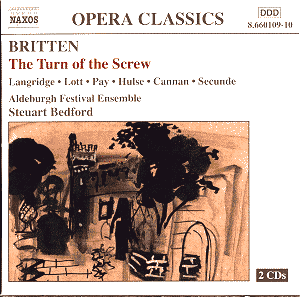This is a reissue of the recording originally
marketed on the Collins Classics label some ten years ago. It
is wonderful to see it back in the catalogue, not least because
it enshrines one of the most memorable operatic characterisations
of recent years, that of Peter Quint by the tenor Philip Langridge.
As in the Hickox Grimes, Langridge is crucial to the success
of the whole venture. Peter Pears, singing on the composer’s own
recording, and who of course created the role of Quint, brings
his customary insight and musicality to the role. But Pears’ timbre
was always wrong for suggesting turbulence or menace – however
hard he tries, he somehow can’t quite squeeze the ‘virtue’ out
of his voice. Langridge, as those who have seen his Quint on the
stage will testify, is a superb vocal actor, who is able to suggest
the character’s evil intent, yet never produces anything other
than ravishingly beautiful tone. In this respect he is superior
to the other distinguished Quint on CD, Robert Tear on Colin Davis’s
set for Philips. Langridge could convince you that the Devil does
indeed have all the best tunes.
He is matched by the rest of the cast. Felicity
Lott, also in fine vocal form, suggests perfectly the anxiety
and vulnerability of the Governess. One of the supreme moments
of the opera, and a stroke of genius on Britten’s part, is the
letter-writing scene in Act 2, where the orchestra, in a near-hysterical
interlude, screams out the theme to which the Governess then reads
back her letter, with enforced composure. Lott is superb here,
as she is in the final scene with Quint and the boy Miles.
The other female parts are all sung with great
accomplishment, though I found Phyllis Cannan sometimes a little
over-emphatic with the words. On the other hand, she mostly achieves
great clarity, which is of huge importance in this fast-moving
and intricate plot. Both of the children sing well, though Eileen
Hulse has a young woman’s rather than a young girl’s voice.
A major plus is the outstanding instrumental
playing. Bedford directs with a confidence and flexibility that
comes from deep knowledge of this score in particular and of Britten’s
style in general. He is well served by his instrumentalists, who
include, in addition to the Brindisi Quartet members, such distinguished
names as Jennifer Stinton on flutes, Nick Daniel on oboe and cor,
and David Owen Norris on piano and celesta.
The recording captures all these musical riches
perfectly, and the production team, headed by John West, have
added much in terms of ambience and perspective, without going
over the top in any way. As soon as I’d finished listening to
this, I immediately wanted to hear it again. That doesn’t often
happen with pieces lasting nearly two hours, and it’s a sincere
recommendation of what was, for me, an exceptionally powerful
musical and dramatic experience.
Gwyn Parry-Jones
